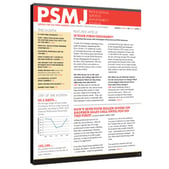 In recent years, several prominent corporations have cut back or rescinded their telecommuting policy. One of the most notable was IBM, which essentially ended the practice in June 2017.
In recent years, several prominent corporations have cut back or rescinded their telecommuting policy. One of the most notable was IBM, which essentially ended the practice in June 2017.
As of 2009, 40 percent of Big Blue’s employees were working remotely, so with it jumping off the bandwagon, media outlets of all kinds were quick to declare the demise of telecommuting.
Telecommuting and flexible work hours can be problematic for the architecture and engineering industry, which has traditionally delivered projects in closely quartered teams. Ours is also an industry notoriously slow to embrace change. Yet, with technology allowing for seamless collaboration, and competition for quality employees fierce, many A/E firm principals have—whether willingly or reluctantly— implemented flex-time and remote workplace policies.
BENEFITS OUTWEIGH PROBLEMS?
The benefits of telecommuting are obvious—little to no time lost to commuting, ability to focus without interruption, customized and comfortable setting, and so on. It has its drawbacks as well, including potential communication difficulties, additional costs and, possibly most disturbing to firm leaders, an inability to monitor time spent on work.
“I guess I’m just old school, or maybe I’m a dinosaur, but I’m not on board with this work from home, flex-time thing,” said one mid-fifties principal for an East Coast engineering firm that allows both on a limited basis. “I feel like I have no control over my own firm. I just don’t think it works, at least not in this company.”
In some cases, firms can go to the other extreme monitoring employees. Some surveyors, inspectors and other field personnel who carry phones or other electronic devices may be subject to tracking by GPS. This is more common in industries such as guard services and municipal public works.
Anecdotal evidence suggests that the norm is to offer employees some flexibility, but that full-fledged telecommuting by technical professionals in A/E firms remains the exception.
MODERATION WORKS
DGR Engineering, a 120-person, five-office firm headquartered in Rock Rapids, IA, offers “some autonomy…without top-heavy oversight,” says vice president/CFO Marlin Overman. However, the freedom and flexibility have their limits.
“We think it’s important that our staff communicate and work together,” Overman says. “For the most part, our employees are office-based. We think this encourages better teamwork and a better result for our clients.”
The policy change by IBM, Yahoo, and other large companies may signal an anti-telecommuting trend, or they may just be coincidental strategic decisions with no wideranging ramifications. Fast Company magazine is among those that argue that telecommuting is here to stay, and likely to grow, no matter what IBM or anyone else does.
Noting that Yahoo’s attempt to improve performance by eliminating telecommuting failed miserably, writer Stephanie Kasriel wrote, “IBM CEO Ginni Rometty is under pressure to turn her company around. And like Yahoo, IBM claims that the policy change is meant to improve collaboration and accelerate innovation. It won’t work.”
Why not? Among the multiple reasons Kasriel offers is one likely to affect remote work in the A/E industry—the best employees have their pick of opportunities in the current job market. If working remotely is an important factor to a high-performing architect or engineer, somebody is likely to offer him or her the flexibility they’re looking for just to get them in the fold.
 This article is featured in PSMJ's November 2017 newsletter, Professional Services Management Journal (PSMJ). In today’s fast-moving information overload world, it seems that there is industry-related content everywhere you look, with some nuggets of advice on how you can be more successful. PSMJ’s carefully-curated content ensures that you are not getting generic filler, hypothetical fluff, or anything but proven battle-tested advice. Check out a free copy available at the link below.
This article is featured in PSMJ's November 2017 newsletter, Professional Services Management Journal (PSMJ). In today’s fast-moving information overload world, it seems that there is industry-related content everywhere you look, with some nuggets of advice on how you can be more successful. PSMJ’s carefully-curated content ensures that you are not getting generic filler, hypothetical fluff, or anything but proven battle-tested advice. Check out a free copy available at the link below.



